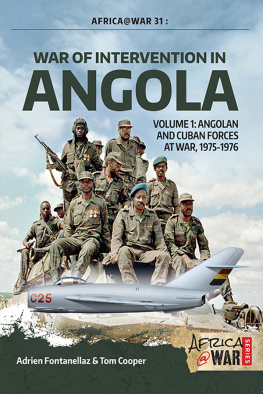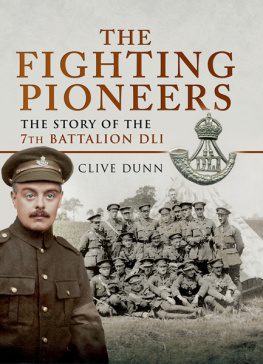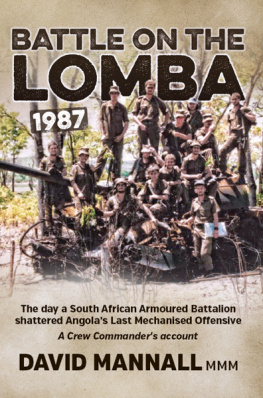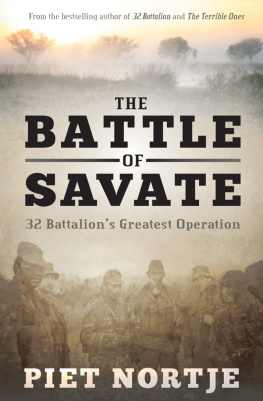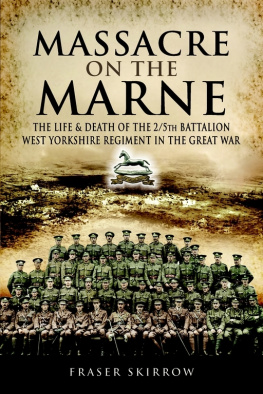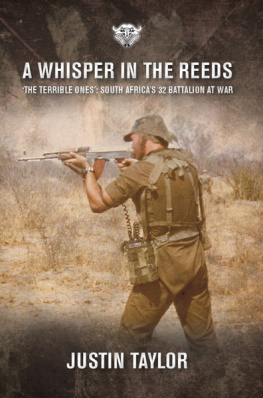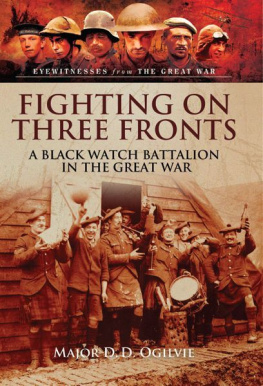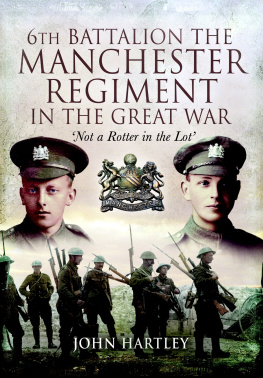
32 Battalion
The Inside Story
of South Africas
Elite Fighting Unit

PIET NORTJE
He which hath no stomach to this fight
Let him depart
But we in it shall be remembered.
We few, we happy few, we band of brothers.
He today that sheds his blood with me
Shall be my brother.
SHAKESPEARE: Henry V, Act 4 Scene 3
Contents
LIST OF MAPS AND ILLUSTRATIONS
PREFACE
ABBREVIATIONS
1 IF YOU WALK THIS WAY, WE CAN WIN
The civil war in Angola
2 I WANT TO BE A SOLDIER
Early days and early battles
3 BUFFALO IS OUR HOME
Putting together a unit
4 THE WAY OF BUFFALO
Training and leadership
5 I LIKE THE TRUMPET
Symbols and traditions
6 THE DANGER OF BUFFALO
Military operations 19761977
7 TO FIGHT TO FIGHT
Military operations 19781979
8 WE WANT FIRE!
Military operations 19801982
9 MY FUNERAL WILL BE ON PATROL
Military operations 19831985
10 WE MARCH WITHOUT FEAR
Military Operations 19851988
11 FIGHTING TILL THE END
Township duty 19891992
12 WE CAME, WE GO
Relocation and disbandment
BROTHER REMEMBER ME
Roll of Honour
TRADITIONAL UNIT SONGS
WEAPONRY, VEHICLES AND AIRCRAFT USED DURING THE ANGOLAN CONFLICT
GLOSSARY OF FOREIGN AND MILITARY TERMS
BIBLIOGRAPHY
List of maps and illustrations
FAPLA and FNLA infiltration and areas of operation, 1974, showing extent of MPLA control
Traditional SWAPO deployments and areas of responsibility in Angola
The advance of Task Force Zulu during Operation Savannah. Details of Battle Group Bravos operations appear on maps 13
MAP 1: Battle Group Bravos advance from the assembly point at Calai to Pereira DEca
The Battle of Pereira DEca, 19 October 1975
MAP 2: Battle Group Bravos advance from Pereira DEca to S da Bandeira
The Battle of Catengue, 2 November 1975
The Bay of Benguela, showing positions of FAPLAs mortars, machine guns and multiple rocket launcher
MAP 3: Battle Group Bravos advance from S da Bandeira to Benguela and the northernmost penetration of Angola before being ordered to withdraw
Orientation map of Caprivi Strip showing position of Pica Pau (1), the kimbo (2) and the final location of Buffalo Base (3)
Construction of Huhnerleiter shelters
Angolan combat theatre and detailed area of 32 Battalion operations 19761988
Operations west of the Cuito River, with deployments and patrols as far north as Cunjamba
SWAPO ambush of Corporal le Rouxs platoon, June 1977
Layout of Eheke 2 base attacked by 32 Battalion, October 1977
Operation Reindeer: third-phase movement and attacks by 32 Battalion
Operation Loodvoet
Routes taken to Savate. Inset: Position of Savate
Layout of Savate and positions of assault force
Operation Sceptic
QFL 13 SWAPO bases spread over 45 square kilometres
Area covered by Operation Butterfly
Operation Carnation
Primary targets, Operation Protea
The attack on central Xangongo, 24 August 1981
Area map showing Iona, Cambeno Valley and Marienfluss
Area of Far East Owamboland targeted by Project Spiderweb
Operation Askari. Note the number of rivers in the area
Operation Forte route followed to Cachueca
FAPLAs push southwards in the 3rd and 6th military regions
Advance of FAPLA brigades and final assault point, 1985
Operation Jerry
Operation Kakebeen
The attack on Cassumbi, February 1987
FAPLAs September 1987 offensive against UNITA
FAPLA positions prior to battles of 13 September 1987
Operation Hilti : SADF, FAPLA/Cuban and SWAPO deployments on 13 June 1988
Pre-1994 South Africa, showing towns and areas relevant to 32 Battalion deployments from 1990
Operation Eardrum area to the south-west of Pietermaritzburg
The province of Natal, with the different areas of responsibility for military groups 9, 10 and 27
Group 27-area with headquarters at Eshowe. The map indicates the deployment destinations of the companies
Preface
MY ENTIRE ADULT life has been that of a soldier, almost half of it spent with one of recent historys most unique fighting units. In 1989, surrounded by veterans and serving members of 32 Battalion, it occurred to me that someone really ought to preserve for posterity the tale of how a ragtag band of foreign freedom fighters became the South African Armys best fighting unit since the Second World War.
Four years later, that same unit had become a political punchbag, consigned to the trash heap by the last apartheid government as soon as this became politically expedient. By then Colonel Jan Breytenbach, founding father of the Buffalo Soldiers, had published two books on the subject, but the first, Forged in Battle, dealt almost entirely with the role played by what was then known as Bravo Group during Operation Savannah, the former SA Defence Forces highly successful 1975 campaign against the communist-backed MPLA in Angola. His second book, They Live by the Sword, covered the period up to 1989, but contained largely anecdotal material, Breytenbach having transferred out of the unit in early 1977. On the eve of disbandment, therefore, the story of a unit unlike any other in the SADF remained untold.
In early 1993, during informal discussions with two former 32 Battalion officers Commandant Werner Sott, outgoing OC 7 SA Infantry Battalion, and his successor, Commandant Daan van der Merwe I ignored the first rule of military service and volunteered to compile the units story. They informed me that someone had already been approached to do so, but I nonetheless began collecting every scrap of information I could find. Towards the end of that year, a staff paper by Major Wally Vrey, entitled The History of 32 Battalion, landed on my desk, and I raised anew the need for a published account, only to be told yet again that one was already in the pipeline.
By January 1998 there was still no sign of either the promised history or the unnamed chronicler. Five years had elapsed since the unit ceased to exist, and my fears were mounting that vital information and verifiable facts would soon be lost forever. I turned to Brigadier General Eddie Viljoen, the battalions longest-serving commanding officer, who not only immediately offered his assistance, but also sound advice on how I should proceed. Armed with the blessing of all former commanding officers and mindful of the need to thoroughly document everything I wrote, given the controversy surrounding South Africas role in the conflict of the past and 32 Battalions contribution in particular, I was eager to begin. But operations in which 32 Battalion was involved were still classified, and without access to official records and documents the book I envisaged would be stillborn.
As a serving member of the SA National Defence Force, I had to obtain authorisation from the chief of the SA Army before I could start mining the wealth of information contained in 2 319 files all stamped Top Secret at the Department of Defences Documentation Centre in Pretoria. From November 1999 to April 2002, the contents of those files were gradually declassified and shaped into the unexpurgated story of an unconventional units war.
Next page

